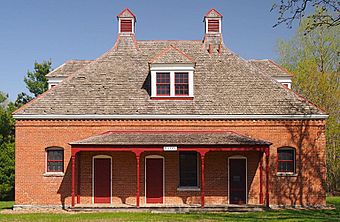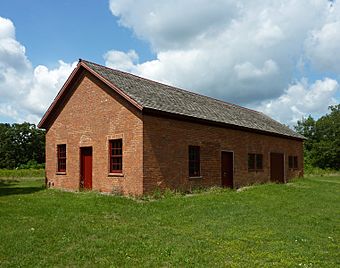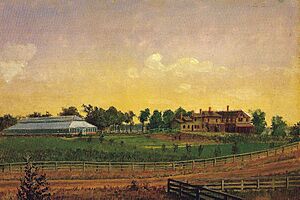North Oaks Farm facts for kids
Quick facts for kids |
|
|
James J. Hill's North Oaks Farm, Dairy Building
|
|

The Dairy Building from the west
|
|
| Location | Red Barn Road and Hill Farm Circle North Oaks, Minnesota |
|---|---|
| Built | 1884 |
| Architectural style | Colonial Revival |
| NRHP reference No. | 97000441 |
| Added to NRHP | May 16, 1997 |
|
James J. Hill's North Oaks Farm Dairy Building, Granary Root Cellar and Auxiliary Buildings, Boundary Increase
|
|

The blacksmith building from the southeast
|
|
| Nearest city | North Oaks, Minnesota |
|---|---|
| Built | 1883 |
| MPS | James J. Hill's North Oaks Farm Buildings MPS |
| NRHP reference No. | 98000311 |
| Added to NRHP | September 9, 1999 |
North Oaks Farm, also known as Hill Farm, is a special place in North Oaks, Minnesota. It's like an open-air museum that keeps old farm buildings safe. These buildings were part of a huge farm started by a famous railroad builder named James J. Hill in 1883. His farm was once about 3,300 acres big! Some parts of the farm are so important that they were added to the National Register of Historic Places in 1999.
One of the main buildings is the Dairy Building. Here, James J. Hill used new machines like a DeLaval separator. These machines helped make butter much faster. They used steam power to spin milk and separate the cream. This was a very early way of making butter in a factory, like how it's done today.
The farm also had a Blacksmith and Machine Shop. This is where horses got new shoes. Workers also made metal parts like hinges and wagon wheels for the farm's needs.
Contents
The Story of North Oaks Farm
How the Farm Started
In 1883, James J. Hill bought a large piece of land in Ramsey County. He paid $50,000 for about 3,500 acres. This land became North Oaks Farm. Later, he bought even more land, making the farm almost 5,500 acres in total. That's a lot of land!
Breeding Special Cows
For the first ten years, North Oaks Farm was a place to raise animals. James J. Hill wanted to create a special kind of cow. He hoped to breed cows that could produce both good milk and good meat. This idea was very popular back then.
Hill spent a lot of money trying to create these "dual-purpose" cows. While his cows produced excellent meat, their milk production was not as good. It was very hard to have a cow that was great at both. However, all the hard work helped the farm become known for its amazing beef cattle.
Award-Winning Animals
Every year, Hill's Aberdeen Angus and Shorthorn cows from North Oaks would travel by train to Chicago. They went to a big event called the Fat Stock Show. His cattle won many awards there over the years. For example, in 1889, his Aberdeen Angus cows won $700 in prizes!
A Family Retreat
North Oaks Farm was also James J. Hill's country home. His family spent most of their summers there. They lived in a large brick house that looked out over Pleasant Lake. The Hill family often had guests visit around the Fourth of July.
Favorite activities included fishing and swimming in Pleasant Lake. They also enjoyed riding horses and going for drives in the countryside. James J. Hill loved to show off his farm. He would spend hours giving tours to his visitors.
Caring for the Land
James J. Hill personally managed all the landscaping at North Oaks. He spent a lot of money to make it beautiful. In 1914 alone, he spent $2,500 on landscaping. His wife, Mary Hill, decided which vegetables and flowers would grow each year. She oversaw the cooks and servants who used these plants at their big house in St. Paul.
What Happened Next
After James J. Hill passed away in 1916, his son, Louis Hill Sr., took over the farm. Louis also loved farming, just like his father.
However, after Louis Hill Jr. passed away in 1948, the farm land was divided up. In the 1950s, it was turned into smaller pieces for homes. The large family estate by the lake was torn down. Most of the farm buildings, including greenhouses and barns, were also removed.
Today, only three of the original forty buildings are left. These are the creamery (Dairy Building), the granary, and the blacksmith shop/engine house.
James J. Hill and Mary Hill were first buried in a private tomb at North Oaks Farm. Later, their remains were moved to Resurrection Cemetery in Mendota Heights.




